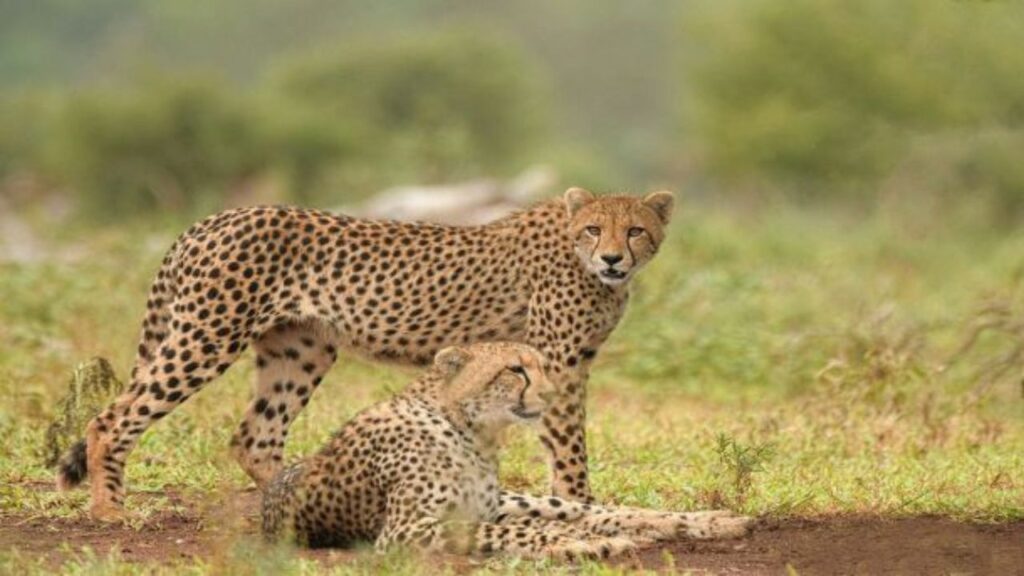Do Cheetahs Attack Humans? Cheetahs rarely attack humans, as they are generally shy and prefer to avoid confrontations.
Cheetahs, renowned for their incredible speed and agility, are among Africa’s most fascinating big cats.
Unlike other large felines, cheetahs have a unique combination of physical adaptations that make them exceptional hunters, capable of reaching speeds up to 60 miles per hour.
These magnificent creatures are primarily solitary, with their behavior and interactions shaped by their role as top predators in their ecosystems.
Understanding cheetahs’ natural behavior and their interactions with humans is crucial for fostering better coexistence and promoting conservation efforts.
Contents
Who Are Cheetahs?
Physical Characteristics and Unique Traits
Cheetahs are renowned for their unparalleled speed and agility, boasting several unique physical characteristics that distinguish them from other big cats.
They possess a slender, aerodynamic body with long, powerful legs, designed specifically for high-speed chases.
Their distinctive black tear marks run from the eyes to the mouth, which are thought to reduce glare from the sun and improve focus on prey.
Cheetahs also have a large nasal passage and lungs that allow for increased oxygen intake during high-speed sprints. [Do Cheetahs Attack Humans?]
Unlike most other big cats, their claws are non-retractable, providing better traction, and their specialized pads on their feet further enhance grip and stability while running.
Natural Habitat and Distribution
Cheetahs primarily inhabit the grasslands and savannas of sub-Saharan Africa, where their speed and agility are suited to open environments that allow for high-speed pursuits.
Historically, their range extended into parts of Asia, but today they are largely confined to Africa due to habitat loss and human activities.
They prefer areas with abundant prey and relatively sparse vegetation, which aids in their hunting strategy by providing clear lines of sight for spotting potential targets.

Cheetah Behavior
Social Structure and Typical Interactions with Other Animals
Cheetahs are predominantly solitary animals, with males and females typically leading independent lives.
However, males often form small groups known as “coalitions,” which are usually composed of brothers.
These coalitions help each other with hunting and territorial defense. Female cheetahs are generally solitary and come together with males only for mating.
Their interactions with other animals are mostly centered around hunting and territorial disputes. Unlike lions or hyenas, cheetahs are not social predators and do not form large groups for hunting.
Predatory Instincts and Hunting Habits
Cheetahs are known for their unique hunting strategy, which relies on speed rather than strength. [Do Cheetahs Attack Humans?]
They use their exceptional eyesight to spot prey from a distance and then initiate a high-speed chase to catch it.
Their sprinting capability, which can reach speeds of up to 60 miles per hour, is used to outrun and capture prey in short bursts.
This method of hunting is energy-intensive, so cheetahs must rest and recover after such high-speed chases.
Their diet primarily consists of small to medium-sized ungulates, such as gazelles and impalas, which are abundant in their grassland habitats.

Human-Cheetah Interactions
Historical Context of Cheetah-Human Encounters
Historically, cheetahs have been admired and utilized by humans for various purposes. In ancient Egypt and Mesopotamia, cheetahs were prized for their elegance and speed.
They were often kept as royal pets and used for hunting games, a practice known as “coursing.” This relationship was generally respectful, with cheetahs being seen as symbols of grace and power.
Throughout history, they were depicted in art and literature, reflecting their esteemed status among ancient civilizations.
However, as human expansion increased, conflicts began to arise due to habitat encroachment and competition for resources.
Recent Cases or Incidents Involving Cheetahs and Humans
In more recent times, interactions between cheetahs and humans have become more frequent, often as a result of expanding agricultural and residential areas encroaching on their natural habitats.
While cheetah attacks on humans are extremely rare, there have been isolated incidents where cheetahs, feeling threatened or cornered, exhibited aggressive behavior.
For instance, there have been reports of cheetahs attacking livestock or pets in areas where their natural prey is scarce.
Additionally, in some cases, cheetahs have been involved in conflicts with farmers or ranchers protecting their herds. [Do Cheetahs Attack Humans?]
These incidents underscore the importance of managing human-wildlife interactions and ensuring that conservation efforts address the needs of both cheetahs and local communities.
Why Cheetahs Rarely Attack Humans
Natural Avoidance Behavior
Cheetahs have evolved with a natural instinct to avoid confrontations with potential threats, including humans.
Unlike some larger big cats, cheetahs are not aggressive by nature and prioritize evasion over engagement.
This instinct to avoid conflict is a survival strategy that helps them conserve energy and stay out of danger. [Do Cheetahs Attack Humans?]
In the wild, cheetahs are known for their ability to swiftly escape from predators or perceived threats rather than confront them.
Cheetahs’ General Fear of Humans
Cheetahs tend to be wary of humans and prefer to keep their distance. Their fear of humans is a significant factor in their rare attacks.
Unlike lions and tigers, which can become more habituated to human presence, cheetahs are generally more skittish and avoid areas with high human activity.
This fear is not only a natural response but also a survival mechanism, as cheetahs are less equipped for physical confrontations compared to other big cats.
Comparison with Other Big Cats
When comparing cheetahs to other big cats, such as lions and tigers, the differences in behavior become apparent.
Lions and tigers, being larger and more powerful, are sometimes more prone to aggressive encounters with humans, especially in regions where their natural prey is scarce or where they have become accustomed to human presence.
In contrast, cheetahs, with their streamlined bodies designed for speed rather than strength, rely on their ability to outrun threats rather than confront them.
This difference in physical capabilities and behavioral adaptations explains why cheetahs are far less likely to attack humans compared to their larger, more aggressive counterparts.

Precautions to Take Around Cheetahs
Guidelines for Safely Observing Cheetahs in the Wild
When observing cheetahs in their natural habitat, it’s essential to maintain a respectful distance to avoid disturbing them. [Do Cheetahs Attack Humans?]
Always use binoculars or telephoto lenses to get a closer view without encroaching on their space. Joining guided safari tours led by experienced wildlife experts can enhance safety and ensure that you follow proper protocols.
Staying in vehicles and keeping noise levels low helps minimize disturbance and reduces the risk of startling these agile predators.
Measures to Avoid Provoking or Disturbing Them
To avoid provoking cheetahs, never attempt to approach or feed them. Sudden movements, loud noises, and direct eye contact can be perceived as threats.
If a cheetah shows signs of agitation, such as crouching or flicking its tail, give it ample space and back away slowly.
Ensuring that cheetah habitats are not encroached upon by human activities, such as agriculture or development, is also crucial in minimizing potential conflicts.
See Also: Do Komodo Dragons Attack Humans? Terrifying Tales!
FAQs
1. Can cheetahs be kept as pets?
Cheetahs are not suitable as pets. Despite their tameness in captivity, they are wild animals with specific needs that cannot be met in a domestic setting. They require vast spaces, specialized diets, and complex enrichment to thrive. Additionally, keeping cheetahs as pets poses significant risks to both the animal and humans.
2. How can you tell if a cheetah is feeling threatened?
A cheetah that feels threatened may exhibit several signs of distress, including flattened ears, a lowered body posture, and a flicking tail. They may also vocalize or make hissing sounds. If a cheetah is displaying these behaviors, it is best to give it space and avoid any actions that could be interpreted as threatening.
3. What should I do if I encounter a cheetah in the wild?
If you encounter a cheetah in the wild, maintain a safe distance and avoid approaching the animal. Remain calm, and do not make sudden movements or loud noises. Observing from a vehicle or a safe vantage point is ideal. If the cheetah appears agitated, slowly back away and give it space.
4. Are cheetahs endangered, and what threats do they face?
Cheetahs are classified as vulnerable, with their populations declining due to habitat loss, human-wildlife conflict, and poaching. Their prey is also being depleted, which impacts their survival. Conservation efforts focus on protecting their habitats, reducing human-wildlife conflict, and supporting anti-poaching measures.
5. How do cheetahs communicate with each other?
Cheetahs use a variety of vocalizations and body language to communicate. They can make chirps, purrs, and hisses to express different emotions or signals. In addition to vocalizations, cheetahs use visual signals, such as tail movements and body posture, to convey their intentions and emotions to other cheetahs.
Conclusion: Do Cheetahs Attack Humans?
In summary, cheetahs are remarkable creatures with a natural tendency to avoid human contact, making attacks on humans extremely rare.
Their behavior is characterized by a preference for evasion rather than confrontation, and they are generally shy and elusive.
By following guidelines for safe observation and respecting their need for space, we can coexist peacefully with these incredible animals.
Understanding and respecting wildlife, including cheetahs, is crucial for their conservation and our safety.
Through mindful interactions, we can help ensure that cheetahs continue to thrive in their natural habitats and maintain the delicate balance of their ecosystems.

Hello, I am Rosa Ellis, a mother of two and a wildlife blogger. I grew up in New York City, but I love exploring forests. I’ve traveled to places like Yellowstone National Park and the Amazon Rainforest to see animals up close. I know a lot about animal behavior and which animals can be dangerous to humans. Thanks for visiting my blog!

